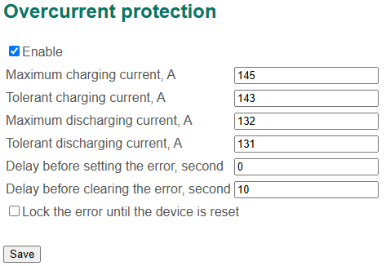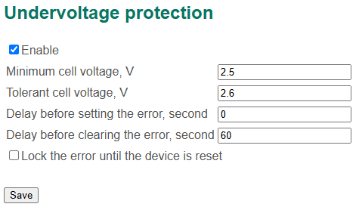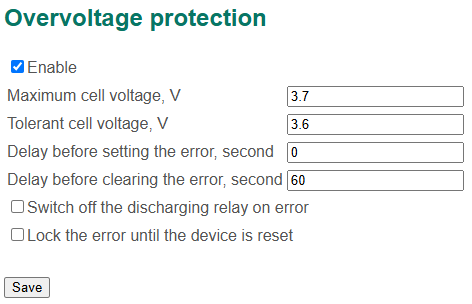The BMS Main 2.x board continuously monitors the state of the cells, BMS Logic boards, the external environment and, when detecting abnormalities, protects the battery and system components from damage.
3.6.1 Overcurrent protection
To change the current protection of the battery, select the menu "Protections → Overcurrent protection":

Overcurrent protection settings
In this section:
- Enable – a flag to enable the protection;
- Maximum charging current, А;
- Tolerant charging current, А;
- Maximum discharging current, А;
- Tolerant discharging current, А;
- Delay before setting the error, second;
- Delay before clearing the error, second;
- Lock the error until the device is reset – a flag to block the error until the board is restarted.
As a result of operation of the current protection, the "Overcurrent" error is generated.
Error generation conditions:
- the current is positive (charging), and its modulo value is greater than the “Maximum charging current” value for the “Delay before setting the error” time;
- the current is negative (discharging), and its modulo value is greater than the “Maximum discharging current” value for the “Delay before setting the error” time.
Conditions for removing the error:
- the current is positive (charging) or zero, and its modulo value is less than the “Tolerant charging current” value for the “Delay before clearing the error” time;
- the current is negative (discharging), and its modulo value is less than the “Tolerant discharging current” value for the “Delay before clearing the error” time.
3.6.2 Undervoltage protection
The board implements battery protection from too low or too high voltage on the cells.
To change the battery protection parameters from low voltage on the cells, select the menu "Protections → Undervoltage protection":

Undervoltage protection settings
In this section:
- Enable – a flag to enable the protection;
- Minimum cell voltage, V;
- Tolerant cell voltage, V;
- Delay before setting the error, second;
- Delay before clearing the error, second;
- Lock the error until the device is reset.
As a result of the operation of battery protection from low voltage, the "Undervoltage" error is generated.
Error generation conditions:
- the minimum voltage among all cells of the battery is less than the “Minimum cell voltage” value for the “Delay before setting the error” time.
Conditions for removing the error:
- the minimum voltage among all cells of the battery is greater than the “Tolerant cell voltage” value for the “Delay before clearing the error” time.
3.6.3 Overvoltage protection
To change the battery protection parameters from high voltage on the cells, select the menu "Protections → Overvoltage protection":

In this section:
- Enable – a flag to enable the protection;
- Maximum cell voltage, V;
- Tolerant cell voltage, V;
- Delay before setting the error, second;
- Delay before clearing the error, second;
- Switch off the discharging relay on error – a flag to open the discharging relay when the "Overvoltage" error is generated;
- Lock the error until the device is reset.
As a result of the operation of the battery protection from high voltage, the "Overvoltage" error is generated.
Error generation conditions:
- the maximum voltage among all cells of the battery is greater than the “Maximum cell voltage” value for the “Delay before setting the error” time.
Conditions for removing the error:
- the maximum voltage among all cells of the battery is less than the “Tolerant cell voltage” value for the “Delay before clearing the error” time.
3.6.4 Low temperature protection
The board implements battery protection from too low temperature.
To change the battery protection parameters from low temperature, select the menu "Protections → Low temperature protection":
In this section:
- Enable – a flag to enable the protection;
- Minimum charging temperature, °C;
- Tolerant charging temperature, °C;
- Minimum discharging temperature, °C;
- Tolerant discharging temperature, °C;
- Delay before setting the error, second;
- Delay before clearing the error, second;
- Lock the error until the device is reset.
As a result of the operation of the battery protection from low temperature, the "Low CH temperature" or “Low DCH temperature” error is generated.
Error generation conditions:
- the minimum temperature among all cells of the battery is less than the “Minimum charging (discharging) temperature” value for the “Delay before setting the error” time.
Conditions for removing the error:
- the minimum temperature among all cells of the battery is greater than the “Tolerant charging (discharging) temperature” value for the “Delay before clearing the error” time.
3.6.5 High temperature protection
The board implements battery protection from too high temperature.
To change the battery protection parameters from high temperature, select the menu "Protections → High temperature protection":
In this section:
- Enable – a flag to enable the protection;
- Maximum charging temperature, °C;
- Tolerant charging temperature, °C;
- Maximum discharging temperature, °C;
- Tolerant discharging temperature, °C;
- Delay before setting the error, second;
- Delay before clearing the error, second;
- Lock the error until the device is reset.
As a result of the operation of the battery protection from high temperature, the "High CH temperature" or “High DCH temperature” error is generated.
Error generation conditions:
- the maximum temperature among all cells of the battery is greater than the “Maximum charging (discharging) temperature” value for the “Delay before setting the error” time.
Conditions for removing the error:
- the maximum temperature among all cells of the battery is less than the “Tolerant charging (discharging) temperature” value for the “Delay before clearing the error” time.
3.6.6 Battery cover protection
To change the protection parameters from opening the battery cover, select the menu "Protections → Battery cover protection":
In this section:
- Enable – a flag to enable the protection;
- Delay before setting the error, second;
- Delay before clearing the error, second;
- Lock the error until the device is reset.
As a result of the operation of the protection against opening the battery cover, the “Battery cover error” is generated.
Error generation conditions:
- there is a signal from the battery cover during the “Delay before setting the error” time.
Conditions for removing the error:
- no signal from the battery cover during the “Delay before clearing the error” time.
